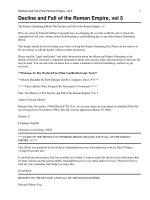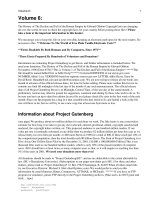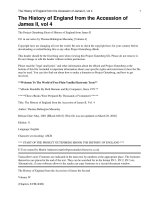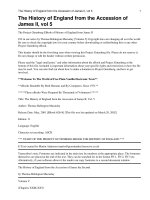The history of russia
Bạn đang xem bản rút gọn của tài liệu. Xem và tải ngay bản đầy đủ của tài liệu tại đây (1.14 MB, 289 trang )
Tai Lieu Chat Luong
THE
HISTORY
OF RUSSIA
ADVISORY BOARD
John T. Alexander
Professor of History and Russian and European Studies,
University of Kansas
Robert A. Divine
George W. Littlefield Professor in American History Emeritus,
University of Texas at Austin
John V. Lombardi
Professor of History,
University of Florida
THE
HISTORY OF
RUSSIA
SECOND EDITION
CHARLES E. ZIEGLER
The Greenwood Histories of the Modern Nations
Frank W. Thackeray and John E. Findling, Series Editors
GREENWOOD PRESS
An Imprint of ABC-CLIO, LLC
Copyright 2009 by Charles E. Ziegler
All rights reserved. No part of this publication may be reproduced, stored in a retrieval
system, or transmitted, in any form or by any means, electronic, mechanical, photocopying,
recording, or otherwise, except for the inclusion of brief quotations in a review, without
prior permission in writing from the publisher.
Library of Congress Cataloging-in-Publication Data
Ziegler, Charles E.
The history of Russia / Charles E. Ziegler.—2nd ed.
p. cm. — (The Greenwood histories of the modern nations)
Includes bibliographical references and index.
ISBN 978-0-313-36307-8 (paper : alk. paper)—ISBN 978-0-313-36308-5
(ebook) 1. Russia—History. 2. Soviet Union—History. 3. Russia
( Federation)—History—1991- I. Title.
DK40.Z54 2009
947— dc22
2009028949
13
12
11
10
09
1
2
3
4
5
This book is also available on the World Wide Web as an eBook.
Visit www.abc-clio.com for details.
ABC-CLIO, LLC
130 Cremona Drive, P.O. Box 1911
Santa Barbara, California 93116–1911
This book is printed on acid-free paper
Manufactured in the United States of America
To Janna and Alan
Map of Russia. [Cartography by Bookcomp, Inc.]
Contents
Series Foreword
ix
Preface
xiii
Preface to the Second Edition
xvii
Timeline of Historical Events
xix
1
Russia and Its People
1
2
Kievan Russia and the Mongol Experience
9
3
Muscovite Russia, 1240–1613
21
4
Russia under the Romanovs: Empire
and Expansion, 1613–1855
33
5
Reform, Reaction, and Revolution, 1855–1921
51
6
Building Communism, 1921–1953
71
viii
Contents
7
De-Stalinization and Developed Socialism, 1953–1985
95
8
Gorbachev, Perestroika, and the Collapse of Communism
123
9
Russia’s Search for Democracy: The Yeltsin Era
149
10
Return to Authoritarianism: Putin and Beyond
181
Notable People in the History of Russia
209
Glossary of Selected Terms
213
Bibliographic Essay
217
Index
225
A photo essay follows page 122
Series Foreword
The Greenwood Histories of the Modern Nations series is intended to provide students and interested laypeople with up-to-date, concise, and analytical histories of many of the nations of the contemporary world. Not since the 1960s
has there been a systematic attempt to publish a series of national histories,
and as series advisors, we believe that this series will prove to be a valuable
contribution to our understanding of other countries in our increasingly interdependent world.
Some 40 years ago, at the end of the 1960s, the Cold War was an accepted
reality of global politics. The process of decolonization was still in progress,
the idea of a unified Europe with a single currency was unheard of, the United
States was mired in a war in Vietnam, and the economic boom in Asia was
still years in the future. Richard Nixon was president of the United States,
Mao Tse-tung (not yet Mao Zedong) ruled China, Leonid Brezhnev guided the
Soviet Union, and Harold Wilson was prime minister of the United Kingdom.
Authoritarian dictators still controlled most of Latin America, the Middle East
was reeling in the wake of the Six-Day War, and Shah Mohammad Reza Pahlavi was at the height of his power in Iran.
Since then, the Cold War has ended, the Soviet Union has vanished, leaving
15 independent republics in its wake, the advent of the computer age has radically transformed global communications, the rising demand for oil makes
x
Series Foreword
the Middle East still a dangerous flashpoint, and the rise of new economic
powers like the People’s Republic of China and India threatens to bring about
a new world order. All of these developments have had a dramatic impact on
the recent history of every nation of the world.
For this series, which was launched in 1998, we first selected nations whose
political, economic, and socio-cultural affairs marked them as among the most
important of our time. For each nation, we found an author who was recognized as a specialist in the history of that nation. These authors worked
cooperatively with us and with Greenwood Press to produce volumes that reflected current research on their nations and that are interesting and informative to their readers. In the first decade of the series, more than 40 volumes
were published, and as of 2008, some are moving into second editions.
The success of the series has encouraged us to broaden our scope to include
additional nations, whose histories have had significant effects on their regions,
if not on the entire world. In addition, geopolitical changes have elevated other
nations into positions of greater importance in world affairs and, so, we have
chosen to include them in this series as well. The importance of a series such
as this cannot be underestimated. As a superpower whose influence is felt all
over the world, the United States can claim a “special” relationship with almost every other nation. Yet many Americans know very little about the histories of nations with which the United States relates. How did they get to be the
way they are? What kind of political systems have evolved there? What kind of
influence do they have on their own regions? What are the dominant political,
religious, and cultural forces that move their leaders? These and many other
questions are answered in the volumes of this series. The authors who contribute to this series write comprehensive histories of their nations, dating back,
in some instances, to prehistoric times. Each of them, however, has devoted a
significant portion of their book to events of the past 40 years because the modern era has contributed the most to contemporary issues that have an impact
on U.S. policy. Authors make every effort to be as up-to-date as possible so that
readers can benefit from discussion and analysis of recent events.
In addition to the historical narrative, each volume contains an introductory
chapter giving an overview of that country’s geography, political institutions,
economic structure, and cultural attributes. This is meant to give readers a
snapshot of the nation as it exists in the contemporary world. Each history
also includes supplementary information following the narrative, which may
include a timeline that represents a succinct chronology of the nation’s historical evolution, biographical sketches of the nation’s most important historical
figures, and a glossary of important terms or concepts that are usually expressed in a foreign language. Finally, each author prepares a comprehensive
bibliography for readers who wish to pursue the subject further.
Series Foreword
xi
Readers of these volumes will find them fascinating and well written. More
importantly, they will come away with a better understanding of the contemporary world and the nations that comprise it. As series advisors, we hope
that this series will contribute to a heightened sense of global understanding
as we move through the early years of the twenty-first century.
Frank W. Thackeray and John E. Findling
Indiana University Southeast
This page intentionally left blank
Preface
Russia is a very large country with a long and complex history. This book
provides a brief, accurate introduction to Russian, Soviet, and post-Soviet history in a readable format that will be of use to high school students, college
students, teachers, and nonspecialists. It includes major social, cultural, and
economic developments so that readers new to the subject will come away
with a good general understanding of this fascinating and troubled country.
For those who wish further reading, the bibliographic essay includes some of
the better known accessible works.
For those who grew up in the post–World War II United States, Russia (or
more accurately, the Soviet Union) was a constant source of fear and attention.
Secretive leaders in the Kremlin, the massive stone fortress in the heart of
Moscow, had sworn to spread communism across the globe. At any time they
might rain thousands of nuclear warheads on America. School children in the
1950s learned to “duck and cover”—to hide under their desks and put their
hands over their heads in the event of a nuclear attack. U.S. taxpayers spent
billions and then trillions of dollars on bombers, missiles, fighter aircraft, submarines, aircraft carriers, troops, tanks, and the other war paraphernalia to defend against the communist threat. Leftists and communist sympathizers were
hounded and persecuted by Senator Joseph McCarthy’s House Un-American
Activities Committee in the 1950s. The United States lost 58,000 men and rent
xiv
Preface
itself apart trying to stop the spread of communism in Vietnam in the 1960s
and early 1970s. In the 1980s, President Ronald Reagan swept into office on a
strong anticommunist platform, pledging to build a space shield that would
provide a comprehensive missile defense for America.
Few experts or government officials expected the Soviet communist government to collapse in 1991. When it did, Americans were overjoyed, expecting that once Russians had rejected dictatorship and socialist economics, they
would quickly learn the ways of democracy and market capitalism. Russians
likewise expected that within a few years they would be as affluent as the
West Europeans, Japanese, or Americans. After all, Russia was a highly educated nation with talented people and vast natural resources. Sadly, as the
20th century drew to a close, these expectations had still not been borne out.
Russia’s economy had shrunk nearly every year since 1991. The government
was deeply in debt, joblessness was rising, and crime was rampant. Russia
had managed to hold several rounds of relatively free presidential and parliamentary elections, but the country’s new democracy was still quite fragile.
Moreover, democratic Russia had had only one president, Boris Yeltsin, and
he was frequently sick and unable to govern.
Americans seem to have lost interest in Russia now that it is no longer communist and seems to pose no threat to the United States or its allies. Russia,
however, is still a major nuclear power, and its leaders are determined that it
will be influential and respected around the world. And Russia may some day
extricate itself from the economic morass into which it has sunk. If that happens, Russia will indeed once again be a power to reckon with.
A brief note on transliteration and pronunciation: Russian names are written
in Cyrillic, and so must be transliterated into the Latin alphabet. This means
that occasionally the same word will be rendered by two different spellings:
for example, tsar and czar. In most cases, I have followed the Library of Congress transliteration style used in the United States, with a few minor modifications for common usage (Trotsky instead of Trotskii). In Russian words and
names, unlike French, all the letters should be pronounced.
Readers should also be aware that until the 20th century, Russia followed
the old, Julian calendar abandoned by Europeans in 1582. The Julian calendar
was inaccurate, so in Russia dates were 12 days behind the modern Gregorian calendar in the 19th century and 13 days behind in the 20th century. The
Bolsheviks adopted the Gregorian calendar in February 1918, but the Russian
Orthodox Church still celebrates its holidays according to the older calendar.
Different dates for events in Russian history therefore are often referred to as
“Old Style” or “New Style,” depending on which calendar was in effect.
Chapter 8 draws in part from Charles E. Ziegler, “The Collapse of the Soviet
Union, 1985–1991: Interpretive Essay,” in Events That Changed the World in the
Preface
xv
Twentieth Century, edited by Frank W. Thackeray and John E. Findling (Westport, CT: Greenwood Press, 1995).
I would like to thank Bruce Adams of the History Department at the University of Louisville for his helpful comments on various chapters. Frank
Thackeray, one of the series’ general editors, also gave me useful feedback
on the manuscript. I am grateful to Dianne O’Regan for compiling the index
and to Justine Ziegler who helped with the proofreading. My greatest debt of
gratitude, however, is to my wife Janna Tajibaeva, whose many insights and
suggestions from her years inside the Soviet Union made the book much better. Her tolerance and encouragement are deeply appreciated, and it is to her
that I dedicate this book.
This page intentionally left blank
Preface to the Second Edition
When this book went to press in 1999, Russia was still struggling with the
transition from communist dictatorship toward a new political and economic
order. The 1990s had been a period of political anarchy, with President Boris
Yeltsin presiding over the dismantling of the planned economy, and newly
rich oligarchs amassing huge fortunes from the privatization of governmentowned assets. The country was not a stable democracy, but at least elections
were held on schedule, dozens of political parties competed for votes, the
media were relatively free to criticize government officials, and Russians were
free to travel and worship as they wished.
Yet many believed the costs of political and economic liberalization were
too high. More than a third of Russians were living in poverty, crime had
soared, disease and alcoholism had contributed to a gradual decline in population, and the nation seemed to be going through a spiritual crisis. Russia was
no longer a respected world power; instead, the Americans and Europeans
ignored Russian national interests and humiliated the nation, while China’s
rise in the east presented a long-term threat.
Vladimir Putin’s popularity can only be fully understood within this
context. His eight years as president saw record economic growth, the stabilization of everyday life, and the restoration of Russia as a powerful state
respected on the world stage. Much of this success had little to do with Putin’s
xviii
Preface to the Second Edition
governance (the country’s economic performance was due mostly to record
high oil and gas prices, for example), but Putin did restore order in Russia,
largely through authoritarian measures that eroded the country’s chances for
developing into a working democracy. He leveraged Russia’s natural resource
wealth into considerable foreign policy influence, at least along the periphery,
if not globally. And Putin made Russians proud of their country once again.
But Russian nationalism resurgent had a dark side, too, in the form of bellicose anti-American rhetoric and skinhead attacks on foreigners.
Chapter 10 takes the reader through the Putin era and into early 2009. I
have also updated the list of notable people, the glossary of terms, and the
bibliographic essay, and have added a list of Web sites for those interested in
keeping current with Russian politics. Once again, I would like to thank Frank
Thackeray for his support and his helpful comments on revising the manuscript. Special thanks, and the dedication, go to Janna Tajibaeva and Alan Taj
Ziegler.
Timeline of Historical Events
1000–700 b.c.
Cimmerians rule southern Russia
700–200 b.c.
Scythians occupy southern Russia
200 b.c.–a.d. 200
Sarmatians rule southern Russia, region had close links
to Greek world
200–370
Goths control Russian steppe
370–453
Rule of Huns
fifth–ninth centuries Various Turkic peoples inhabit southern Russia
862
Riurik of Varangians (Scandinavian tribe) establishes
Riurikid dynasty
980–1015
Vladimir, Grand Prince of Kiev
988
Official conversion of Kievan Rus to Orthodox
Christianity
1132–1136
Emergence of Novgorod city-state
1147
First mention of Moscow in the chronicles
1237–1240
Mongol conquest of Russian lands
xx
Timeline of Historical Events
1242
Aleksandr Nevskii defeats Teutonic Knights
1327–1341
Ivan I (Moneybag), Grand Prince of Moscow
1337
Holy Trinity–Saint Sergius Monastery founded
1367
Stone fortress (kreml) constructed in Moscow
1462–1505
Ivan III, Grand Prince of Moscow
1478
Moscow annexes Novgorod
1547–1584
Ivan IV (The Terrible), tsar of Russia
1552
Conquest of Kazan; construction of St. Basil’s Cathedral
in Moscow
1582
Ermak’s conquest of western Siberia
1584–1613
Time of Troubles
1613
Mikhail Romanov elected tsar (1613–1645); start of
Romanov dynasty
1645–1676
Reign of Tsar Alexis
1649
Adoption of Law Code (Ulozhenie)
1653–1667
Orthodox Church reforms lead to schism
1667–1671
Rebellion under Stenka Razin
1682–1725
Reign of Peter I (The Great), tsar of Russia
1689
Treaty of Nerchinsk between Russia and China
1700–1721
Sweden and Russia fight Northern War
1703
St. Petersburg founded as Peter’s “Window on the
West”
1709
Russian victory over Swedes at Poltava
1714
Establishment of Naval Academy in St. Petersburg
1722
Establishment of Table of Ranks
1736–1739
Russo-Turkish War
1741–1761
Reign of Tsarina Elizabeth
1755
Establishment of Moscow University
1762–1796
Reign of Catherine II (The Great)
Timeline of Historical Events
xxi
1768–1774
Russo-Turkish War
1773–1775
Pugachev Rebellion
1781–1786
Ukraine absorbed into the Russian Empire
1787–1792
Russo-Turkish War
1793–1795
Second and Third Partitions of Poland
1796–1801
Reign of Paul
1801–1825
Reign of Aleksandr I
1801
Annexation of Georgia by Russia
1807–1811
Mikhail Speransky’s reforms
1812
Napoleon’s invasion of Russia
1819
St. Petersburg University established
1825
Revolt and suppression of the Decembrists
1825–1855
Reign of Nicholas I
1830–1831
Polish Rebellion
1842–1851
Construction of St. Petersburg-Moscow railway, the
first rail line in Russia
1853–1856
Crimean War
1855–1881
Reign of Aleksandr II, the “Tsar Liberator”
1861
Emancipation Manifesto frees serfs
1864
Zemstvo (local government), legal, and education
reforms
1865–1885
Conquest of Central Asian regions, absorption into
Russian empire
1872
Publication of Karl Marx’s Das Kapital in Russian
1877–1878
Russo-Turkish War
1881
People’s Will assassinates Aleksandr II in St. Petersburg
1881–1894
Reign of Aleksandr III
1891–1892
Famine in Russia
1891–1904
Construction of Trans-Siberian railway
xxii
Timeline of Historical Events
1894–1917
Reign of Nicholas II
1898
Founding of Russian Social Democratic Labor Party
(RSDLP)
1902
Vladimir Lenin publishes What Is to Be Done?
1903
RSDLP splits into Bolshevik and Menshevik factions at
second congress
1904–1905
Russo-Japanese War
1905–1907
Bloody Sunday massacre leads to Revolution of 1905;
Duma created
1911
Assassination of Prime Minister Peter Stolypin
1914–1918
World War I
1916
Murder of Gregory Rasputin, confidant of the Royal
Family
1917
February Revolution; abdication of Nicholas; rule by
Provisional Government; Bolshevik coup in October
1918–1921
Civil War pits Reds against Whites; tsar and family
killed at Ekaterinburg
1920
War with Poland
1921
Tenth Party Congress; ban on Party factions
1921–1928
New Economic Policy (NEP)
1922
Joseph Stalin appointed General Secretary of Communist Party
1922
Union Treaty creates Union of Soviet Socialist Republics
1924
Death of Vladimir Lenin
1928
Start of Five-Year Plans
1929
Stalin defeats the “Right Opposition,” consolidates his
power
1929–1939
Collectivization of agriculture
1932–1933
7.5 million die from famine
1934
Assassination of Leningrad Party Secretary Sergei
Kirov
1936
Promulgation of Stalin Constitution
Timeline of Historical Events
xxiii
1936–1938
Show trials, purges
1939
Molotov-Ribbentrop Non-Aggression Pact
1940
USSR annexes Baltic states
1941–1945
Great Fatherland War (World War II)
1945–1948
Communist parties consolidate control of Eastern
Europe
1946–1948
Zhdanovshchina, cultural repression and isolation
1949
Victory of communists under Mao Zedong in China
1949
Formation of Council for Mutual Economic Assistance
1950
Mao visits Moscow; Sino-Soviet Treaty signed; outbreak of Korean War
1953
Death of Joseph Stalin; Nikita Khrushchev becomes
General Secretary
1955
Formation of Warsaw Pact military alliance
1956
Twentieth Party Congress; Khrushchev’s
De-Stalinization speech
1956–1962
The Thaw (period of cultural relaxation)
1956
Soviet troops crush Hungarian Revolution
1957
Anti-Party Group tries to oust Khrushchev and fails
1957
Soviet Union launches first spacecraft, Sputnik
1957
Creation of regional economic councils (sovnarkhozy)
1958
Boris Pasternak awarded Nobel Prize for Dr. Zhivago
1959
Sino-Soviet split becomes public
1961
Construction of Berlin Wall
1962
Publication of Aleksandr Solzhenitsyn’s One Day in the
Life of Ivan Denisovich in Novyi Mir
1962
Cuban Missile Crisis
1964
Khrushchev deposed; Leonid Brezhnev becomes Party
General Secretary; Alexei Kosygin becomes Premier
1965–1968
Kosygin economic reforms
1966
Trial of dissidents Iulii Daniel and Andrei Siniavsky
xxiv
Timeline of Historical Events
1968
Warsaw Pact invasion of Czechoslovakia
1969
USSR and China exchange fire along Sino-Soviet
border
1972
Beginning of détente: SALT I and ABM Treaties, U.S.Soviet summitry
1975
Physicist Andrei Sakharov awarded Nobel Peace Prize
1977
Promulgation of Brezhnev Constitution
1979
SALT II Treaty
1979
Soviet troops invade Afghanistan
1980–1981
Solidarity labor movement in Poland
1982
Brezhnev dies; Iurii Andropov becomes General
Secretary
1984
Andropov dies; Konstantin Chernenko becomes
General Secretary
1985
Chernenko dies; Mikhail Gorbachev becomes General
Secretary
1986
Explosion at Chernobyl nuclear reactor in Ukraine
1986
Nationalist demonstrations in Alma Ata, Kazakhstan
1987
Gorbachev begins economic reforms; political liberalization accelerates
1988
Nineteenth Party Conference discusses reform
1989
Elections to Congress of People’s Deputies; Soviet withdrawal from Afghanistan; Eastern Europeans abandon
communism; fall of Berlin Wall; conflict between Armenia and Azerbaijan over Karabagh; Gorbachev repairs
Sino-Soviet relations
1990
Elections to Russian Congress of People’s Deputies;
Gorbachev elected President of USSR; Conventional
Forces treaty in Europe
1991
Foreign Minister Eduard Shevardnadze resigns, warning of coup d’état; Boris Yeltsin elected President of
Russia; conservatives attempt coup d’état in August;
dissolution of USSR and formation of Commonwealth
of Independent States (CIS)









